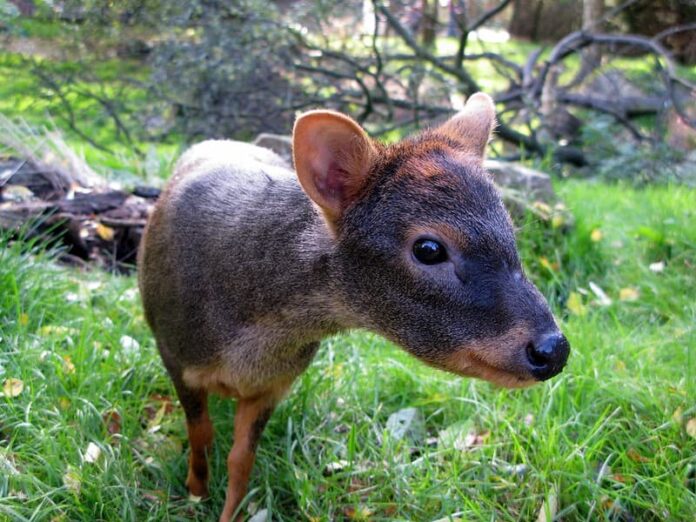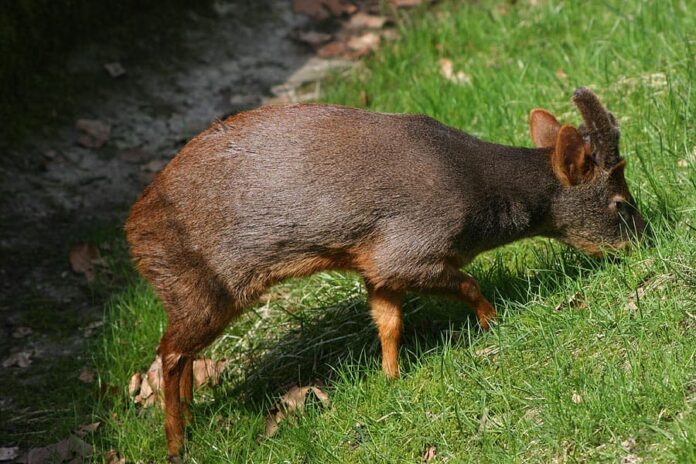Pudu, the world’s smallest deer whose appearance is rather confusing at first. At a glance, it looks like a crossbreed between a deer and a dog which is weirdly cute somehow. This tiny cousin of Bambi here has captured many people’s hearts due to their adorable size and innocent face. For those who haven’t heard of them, today is your lucky day. Now you can add one more cute animal to your list because you might love pudu too. I did my research and you are going to read some interesting things that I found out about them below.
1Appearance

Pudu is a very small deer that stands from 13 to 17 inches (32 to 44 centimeters) tall. It has a stocky body supported by short and slender legs, and it does not have a tail. They have strong hind legs that allow them to run very fast if need be, and they easily outrun larger predators. The color of a pudu ranges from dark- brown to reddish-brown depending on the individual genes, season, and sex. Its fur is long and stiff, typically pressed close to the body, and the females have white spots on their bodies. You can notice the difference between a male and a female by the short spiked antlers that only the males have. Male pudus shed their antlers in June every year, and the new ones also grow back every year.
2Behavior

Pudus are active during the day and sometimes at night, spending time in the middle of the day grooming and resting. You may see them feeding alone while at other times they move together in a group of 2 or 3. Despite looking tiny, pudus are territorial animals with a home range of about 40 to 60 acres. Along with that, they are also very cautious animals when they are foraging. A pudu moves slowly, stops often, and smells the air for the scent of potential predators. Small animals are fast, and pudus are not different from that. They can climb, jump, and sprint, and they will flee in a zigzag path if a predator pursues them. Pudus also jump and skip when they are excited which is absolutely adorable to see.
Surprisingly, pudus are polygynous which means one male mates with multiple females. Size doesn’t matter, you see? Their mating season is from April to June, and a female’s gestation is around 7 months. After mating season ends, the males will continue their solitary life while the females bear and nurse the offspring. The mother cares for her young entirely on her own until it is ready to have babies of their own. A southern pudu can live up to 17 years in the wild but only around 15 years in captivity. These tiny deer are one of the neat animals that defecate in certain areas instead of doing it all over the place. This is also the way they mark their territory, leaving their dung to declare their region. Are pudus friendly? Not really, they are solitary and territorial so they don’t usually interact with other animals or people.
3Feeding & Habitats

As herbivores, these browsers feed on a number of herbs, shrubs, and vegetables that are available in their habitats. Their diet consists of berries, ferns, fruit, fungi, grass, leaves, trees, and vines that they can find. In captivity, pudus can also eat acorns, alfalfa hay, cereal, nuts, and even salt. Pudus receive moisture and water from the food that they feed on, so drinking water is not necessary. This is also why pudus can survive without drinking water for a very long time in the wild.
There are two species of pudu including northern pudu and southern pudu, and both of them live in different habitats. Northern pudu inhabits the northern Andes of Colombia, Ecuador, Peru, and Venezuela while the southern species live in the southern Andes. Whether north or south, both pudus prefer living in an arid summer and damp moderate winter. More than that, they love temperate rainforests with bamboo thickets and dense underbrush that offer them cover from natural predators. Pudus are also found in evergreen forests and mountains, depending on the location that they live in.
4Predators & Threat

Domestic dogs are one of the common predators that attack these small deer. The major predators of pudus are cougars, foxes, eagle owls, and small cats that share their habitats with them. Sometimes their ability to climb trees and run in a zigzag pattern saves their lives from predators. But if those larger animals are faster, then a pudu can also become a meal. However, the predators in the wild are not the reason that threatens their population; humans are.
The main threat to pudus is habitat destruction including cattle ranching, logging, and other human activities. The conversion of forests to plantations and open lands affects greatly to the survival of wild animals like pudus. Along with that, hunting and road accidents also contribute to the deaths of these animals in recent years as well. Another threat is the food competition of introduced species into their range. People also illegally capture and smuggle them to sell as pets worldwide. The data of the northern pudus is deficient while the southern pudus are classified as Near Threatened.
Related Post: World’s Largest Deer




